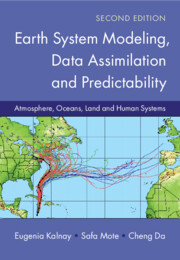4111 results
The Making of Leaderful Mobilization
- Power and Contention in Hong Kong
- Coming soon
-
- Expected online publication date:
- December 2024
- Print publication:
- 30 November 2024
-
- Book
- Export citation

The Third Indochina War
- An International History
- Coming soon
-
- Expected online publication date:
- November 2024
- Print publication:
- 31 October 2024
-
- Book
- Export citation

Earth System Modeling, Data Assimilation and Predictability
- Atmosphere, Oceans, Land and Human Systems
- Coming soon
-
- Expected online publication date:
- October 2024
- Print publication:
- 30 November 2024
-
- Textbook
- Export citation
Polyjuralism Meets Polyglotism: An LL.B. in Chinese Law and Global Legal Studies in the English Language
-
- Journal:
- Asian Journal of Law and Society , First View
- Published online by Cambridge University Press:
- 23 September 2024, pp. 1-21
-
- Article
-
- You have access
- Open access
- HTML
- Export citation
Linear stability analysis of generalized Couette–Poiseuille flow: the neutral surface and critical properties
-
- Journal:
- Journal of Fluid Mechanics / Volume 995 / 25 September 2024
- Published online by Cambridge University Press:
- 20 September 2024, R3
-
- Article
- Export citation
Asymptotics for the sum-ruin probability of a bi-dimensional compound risk model with dependent numbers of claims
- Part of
-
- Journal:
- Probability in the Engineering and Informational Sciences , First View
- Published online by Cambridge University Press:
- 20 September 2024, pp. 1-15
-
- Article
-
- You have access
- Open access
- HTML
- Export citation
A scoping review of empirical studies on informal music learning
-
- Journal:
- British Journal of Music Education , First View
- Published online by Cambridge University Press:
- 18 September 2024, pp. 1-19
-
- Article
- Export citation
Differential viral load of surgical masks worn by patients infected with respiratory viruses
-
- Journal:
- Antimicrobial Stewardship & Healthcare Epidemiology / Volume 4 / Issue S1 / July 2024
- Published online by Cambridge University Press:
- 16 September 2024, p. s141
-
- Article
-
- You have access
- Open access
- Export citation
Modeling and simulation study of end around taxiway operation of Shanghai Hongqiao Airport
-
- Journal:
- The Aeronautical Journal , First View
- Published online by Cambridge University Press:
- 16 September 2024, pp. 1-17
-
- Article
- Export citation
Design of a robotic gripper for casting sorting robots with rigid–flexible coupling structures
-
- Journal:
- Robotica , First View
- Published online by Cambridge University Press:
- 13 September 2024, pp. 1-19
-
- Article
- Export citation
Decay rate of homogeneous isotropic turbulence laden with finite-size particles
-
- Journal:
- Journal of Fluid Mechanics / Volume 993 / 25 August 2024
- Published online by Cambridge University Press:
- 13 September 2024, A15
-
- Article
- Export citation
Solid bases and functorial constructions for (p-)Banach spaces of analytic functions
- Part of
-
- Journal:
- Proceedings of the Edinburgh Mathematical Society , First View
- Published online by Cambridge University Press:
- 09 September 2024, pp. 1-32
-
- Article
- Export citation
Improving social cognition following theta burst stimulation over the right inferior frontal gyrus in autism spectrum: an 8-week double-blind sham-controlled trial
-
- Journal:
- Psychological Medicine , First View
- Published online by Cambridge University Press:
- 06 September 2024, pp. 1-12
-
- Article
- Export citation
Obstacle arrangement can control flows through porous obstructions
-
- Journal:
- Journal of Fluid Mechanics / Volume 992 / 10 August 2024
- Published online by Cambridge University Press:
- 28 August 2024, A3
-
- Article
-
- You have access
- Open access
- HTML
- Export citation
Non-universality and dissipative anomaly in compressible magnetohydrodynamic turbulence
-
- Journal:
- Journal of Fluid Mechanics / Volume 992 / 10 August 2024
- Published online by Cambridge University Press:
- 27 August 2024, A9
-
- Article
- Export citation
Effects of Carvedilol and Metoprolol on the Myocardium During Mechanical Unloading in a Rat Heterotopic Heart Transplantation Model – CORRIGENDUM
-
- Journal:
- Cardiology in the Young , First View
- Published online by Cambridge University Press:
- 27 August 2024, p. 1
-
- Article
-
- You have access
- HTML
- Export citation
Childhood socio-economic disadvantages versus adverse care experiences: Mediation and moderation impacts on late-life depressive symptoms
-
- Journal:
- European Psychiatry / Volume 67 / Issue 1 / 2024
- Published online by Cambridge University Press:
- 27 August 2024, e47
-
- Article
-
- You have access
- Open access
- HTML
- Export citation
The modulation effect of cognition on the interpretation bias of mentalization in late-life depression (LLD): A study of eye gaze interpretation – a potential screening tool for high-risk group of LLD
-
- Journal:
- European Psychiatry / Volume 67 / Issue S1 / April 2024
- Published online by Cambridge University Press:
- 27 August 2024, p. S636
-
- Article
-
- You have access
- Open access
- Export citation
Experimental study on the settling motion of coral grains in still water
-
- Journal:
- Journal of Fluid Mechanics / Volume 990 / 10 July 2024
- Published online by Cambridge University Press:
- 14 August 2024, A15
-
- Article
-
- You have access
- Open access
- HTML
- Export citation
Are Opioid Receptor Antagonists Effective at Treating Antipsychotic-Induced Weight Gain? A Systematic Review and Meta-Analysis
-
- Journal:
- BJPsych Open / Volume 10 / Issue S1 / June 2024
- Published online by Cambridge University Press:
- 01 August 2024, pp. S89-S90
-
- Article
-
- You have access
- Open access
- Export citation









































